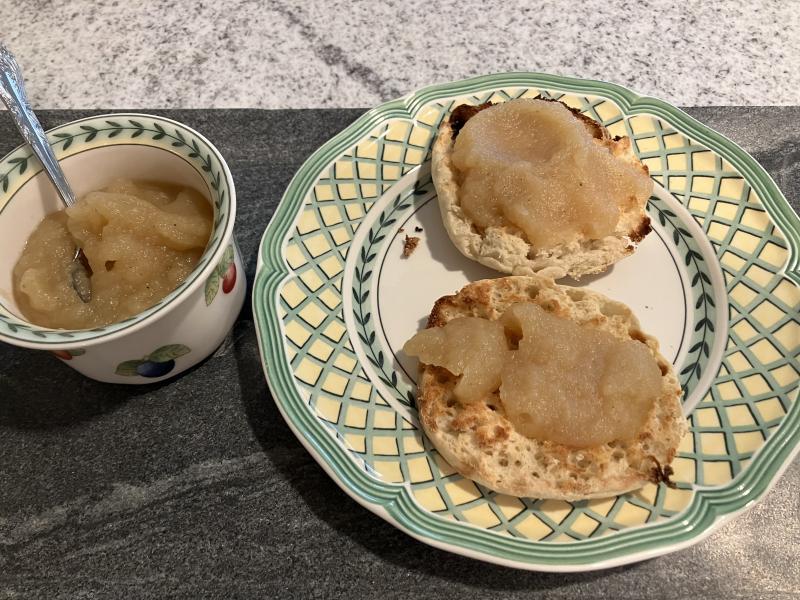Applesauce and apple butter bring the warm flavors of fall
When it comes to making applesauce, there are two approaches – one calls for more work at the start, while the other has the most work in the final step. But first, what is applesauce? Exactly what the name might conjure, a thick purée or sauce of cooked apples that can be as chunky or as smooth as your preference dictates. According to food historians, recipes for applesauce date back to the Roman Empire.
What may also be interesting is how applesauce is served. It has long been the preferred accompaniment to fatty meats, likely because of its properties as an aid to digestion. Early cookbooks instructed the reader to simmer apples and mash them into a side dish for pork, lamb and goose, so as to offset the fat in the main course. While the spice most commonly associated with applesauce is cinnamon, there are others that add lovely flavors.
When we step back to the process for making applesauce, there are essentially two ways. The most basic version entails paring and coring the apples, then steaming them until they disintegrate. You can add seasonings at the start of the cooking process or stir them in later. Rather than cover the apples with water, you will enjoy more flavor if you simply add a small amount of orange juice or apple cider.
The other version requires a kitchen tool called a food mill, designed for mashing and sieving soft foods. It consists of a handled bowl with a perforated bottom plate. A crank with a fitted metal blade sits inside the bowl, and as it is turned, the contents are crushed and forced through the holes, leaving behind any seeds or undesirable clumps, such as pieces of skin.
To make applesauce with this tool, the fruit is roughly chopped, but the skin and seeds are left intact. Once cooked down, when the flesh has softened into mush, the mixture is sent through the food mill to create a puree that will often have a rosy color imparted by the apple skins. This will be far superior to anything you find in the supermarket in cans, jars or plastic cups.
One of the frequent questions you might hear about applesauce is which apple is best and which one should be chosen. In my experience, you will do best to combine a mixture of different apple types to maximize the complexity of the apple flavor. Many pundits advocate McIntosh and Golden Delicious, only because they are soft and cook quickly. Instead, look for a range of options with qualities described as sharp, sweet, crisp and tart.
Making applesauce is a fairly straightforward and quite forgiving process. Cook the apples until they turn into pulp. To go a step further, you can transform your applesauce into apple butter, which is darker in color and thicker in texture, with a glossy, burnished appearance. You are simply evaporating out the liquid, concentrating the apple essence. This is a delicious alternative to jam on your breakfast toast or peanut butter sandwich.
Apple butter requires patience and close attention to the slow cooking process, so you don’t scorch the bottom of the pan and lose all that apple wonderfulness. The recipe below calls for a mixture of spices, but feel free to omit any that are not to your taste. You can begin with a jar of unsweetened commercial applesauce or the latest batch of your homemade version.
Applesauce
6 C peeled, chopped apples
1/2 t lemon zest
1 cinnamon stick
1/3 C orange juice
Combine ingredients in a heavy pot. Cover and simmer, stirring occasionally until the apples are tender. Remove cover and cook over medium heat until thickened. If a smoother consistency is desired, remove cinnamon stick and purée in a food processor or with an immersion blender. Yield: 4 to 6 servings.
Food Mill Applesauce
4 large apples
1/2 t lemon zest
1 cinnamon stick
1/3 C orange juice
Do not peel the apples, simply chop and place in a heavy pot. Stir in remaining ingredients. Cover and simmer, stirring occasionally, until the apples are tender. Remove cover and cook over medium heat until thickened. Allow to cool slightly, then remove cinnamon stick and process through a food mill to yield a creamy mash. Discard any seeds or skins remaining in the bottom of the food mill. Yield: 4 to 6 servings.
Apple Butter
3 C applesauce
1/2 t cinnamon
1/4 t nutmeg
1/4 t allspice
1/4 t cardamom
1/4 t cloves
1/4 t ginger
Combine the applesauce and spices in a heavy-bottomed saucepan. Stir together and bring to a boil over high heat. Simmer over medium while stirring constantly, watching out for spits and spatters. The apple butter has reached the right consistency when you can drag a spatula across the pan and the trail remains. It will continue to thicken as it cools. Transfer the apple butter into a lidded jar and refrigerate for up to two months.
Send comments, questions, and recipe suggestions to capeflavors@comcast.net.























































